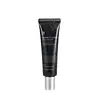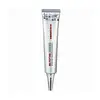What's inside
What's inside
 Key Ingredients
Key Ingredients

 Benefits
Benefits

 Concerns
Concerns

 Ingredients Side-by-side
Ingredients Side-by-side

Galactomyces Ferment Filtrate
HumectantLactobacillus/Collagen Ferment Filtrate
HumectantButylene Glycol
HumectantCaprylic/Capric Triglyceride
MaskingGlycerin
HumectantCetearyl Alcohol
EmollientCetyl Ethylhexanoate
EmollientMacadamia Integrifolia Seed Oil
Skin ConditioningWater
Skin Conditioning1,2-Hexanediol
Skin ConditioningCetearyl Olivate
Pentylene Glycol
Skin ConditioningBifida Ferment Lysate
Skin ConditioningCeramide NP
Skin ConditioningSorbitan Olivate
EmulsifyingSorbitan Stearate
EmulsifyingPropanediol
SolventBetaine
HumectantPanthenol
Skin ConditioningSodium Hyaluronate
HumectantAloe Barbadensis Leaf Extract
EmollientAlthaea Rosea Root Extract
HumectantBeta-Glucan
Skin ConditioningCopper Tripeptide-1
Skin ConditioningPalmitoyl Pentapeptide-4
Skin ConditioningPalmitoyl Tripeptide-1
Skin ConditioningHexapeptide-11
Skin ConditioningHexapeptide-9
Skin ConditioningTripeptide-1
Skin ConditioningAllantoin
Skin ConditioningAcrylates/C10-30 Alkyl Acrylate Crosspolymer
Emulsion StabilisingIsopentyldiol
HumectantArginine
MaskingSucrose Palmitate
EmollientSodium Surfactin
CleansingAdenosine
Skin ConditioningCaprylyl Glycol
EmollientCitrus Paradisi Fruit Extract
Skin ConditioningTocopherol
AntioxidantSchisandra Chinensis Fruit Extract
Skin ConditioningPerilla Ocymoides Leaf Extract
TonicAcorus Calamus Root Extract
PerfumingPolyglyceryl-10 Laurate
Skin ConditioningGalactomyces Ferment Filtrate, Lactobacillus/Collagen Ferment Filtrate, Butylene Glycol, Caprylic/Capric Triglyceride, Glycerin, Cetearyl Alcohol, Cetyl Ethylhexanoate, Macadamia Integrifolia Seed Oil, Water, 1,2-Hexanediol, Cetearyl Olivate, Pentylene Glycol, Bifida Ferment Lysate, Ceramide NP, Sorbitan Olivate, Sorbitan Stearate, Propanediol, Betaine, Panthenol, Sodium Hyaluronate, Aloe Barbadensis Leaf Extract, Althaea Rosea Root Extract, Beta-Glucan, Copper Tripeptide-1, Palmitoyl Pentapeptide-4, Palmitoyl Tripeptide-1, Hexapeptide-11, Hexapeptide-9, Tripeptide-1, Allantoin, Acrylates/C10-30 Alkyl Acrylate Crosspolymer, Isopentyldiol, Arginine, Sucrose Palmitate, Sodium Surfactin, Adenosine, Caprylyl Glycol, Citrus Paradisi Fruit Extract, Tocopherol, Schisandra Chinensis Fruit Extract, Perilla Ocymoides Leaf Extract, Acorus Calamus Root Extract, Polyglyceryl-10 Laurate
Panax Ginseng Callus Culture Extract
Skin ConditioningAspergillus/Rice Ferment Filtrate
Skin ConditioningButylene Glycol
HumectantStearic Acid
CleansingGlycerin
HumectantDicaprylyl Carbonate
EmollientNiacinamide
Smoothing1,2-Hexanediol
Skin ConditioningLactobacillus/Lemon Peel Ferment Extract
Skin ConditioningCitrus Aurantium Dulcis Peel Extract
Emulsion StabilisingSh-Polypeptide-11
Sh-Oligopeptide-2
Skin ConditioningAcetyl Hexapeptide-8
HumectantHexapeptide-12
Skin ConditioningPolyglyceryl-3 Stearate
EmulsifyingCetearyl Olivate
Betaine
HumectantSodium Hyaluronate
HumectantPalmitoyl Tripeptide-5
Skin ConditioningCopper Tripeptide-1
Skin ConditioningSorbitan Laurate
EmulsifyingHydroxyethylcellulose
Emulsion StabilisingAcetyl Dipeptide-1 Cetyl Ester
Skin ConditioningGinsenosides
Skin ConditioningColloidal Platinum
AntimicrobialHydrolyzed Collagen
EmollientPunica Granatum Fruit Extract
AntioxidantFicus Carica Fruit Extract
HumectantMorus Alba Fruit Extract
AntioxidantGinkgo Biloba Nut Extract
Skin ConditioningArnica Montana Flower Extract
MaskingArtemisia Absinthium Extract
Skin ConditioningAchillea Millefolium Extract
CleansingGentiana Lutea Root Extract
Skin ConditioningChamomilla Recutita Flower Extract
MaskingPolyglutamic Acid
Skin ConditioningAscorbyl Glucoside
AntioxidantGrifola Frondosa Fruiting Body Extract
EmollientMaltodextrin
AbsorbentMagnolia Kobus Bark Extract
Skin ConditioningHydrolyzed Hyaluronic Acid
HumectantBiosaccharide Gum-1
HumectantDipeptide Diaminobutyroyl Benzylamide Diacetate
Skin ConditioningBeta-Glucan
Skin ConditioningCamellia Japonica Seed Oil
EmollientTocopherol
AntioxidantCarbomer
Emulsion StabilisingAllantoin
Skin ConditioningArginine
MaskingLavandula Angustifolia Oil
MaskingBoswellia Carterii Oil
MaskingCitrus Aurantium Dulcis Peel Oil
MaskingCitrus Nobilis Peel Oil
MaskingAdenosine
Skin ConditioningPanax Ginseng Callus Culture Extract, Aspergillus/Rice Ferment Filtrate, Butylene Glycol, Stearic Acid, Glycerin, Dicaprylyl Carbonate, Niacinamide, 1,2-Hexanediol, Lactobacillus/Lemon Peel Ferment Extract, Citrus Aurantium Dulcis Peel Extract, Sh-Polypeptide-11, Sh-Oligopeptide-2, Acetyl Hexapeptide-8, Hexapeptide-12, Polyglyceryl-3 Stearate, Cetearyl Olivate, Betaine, Sodium Hyaluronate, Palmitoyl Tripeptide-5, Copper Tripeptide-1, Sorbitan Laurate, Hydroxyethylcellulose, Acetyl Dipeptide-1 Cetyl Ester, Ginsenosides, Colloidal Platinum, Hydrolyzed Collagen, Punica Granatum Fruit Extract, Ficus Carica Fruit Extract, Morus Alba Fruit Extract, Ginkgo Biloba Nut Extract, Arnica Montana Flower Extract, Artemisia Absinthium Extract, Achillea Millefolium Extract, Gentiana Lutea Root Extract, Chamomilla Recutita Flower Extract, Polyglutamic Acid, Ascorbyl Glucoside, Grifola Frondosa Fruiting Body Extract, Maltodextrin, Magnolia Kobus Bark Extract, Hydrolyzed Hyaluronic Acid, Biosaccharide Gum-1, Dipeptide Diaminobutyroyl Benzylamide Diacetate, Beta-Glucan, Camellia Japonica Seed Oil, Tocopherol, Carbomer, Allantoin, Arginine, Lavandula Angustifolia Oil, Boswellia Carterii Oil, Citrus Aurantium Dulcis Peel Oil, Citrus Nobilis Peel Oil, Adenosine
 Reviews
Reviews

Ingredients Explained
These ingredients are found in both products.
Ingredients higher up in an ingredient list are typically present in a larger amount.
1,2-Hexanediol is a synthetic liquid and another multi-functional powerhouse.
It is a:
- Humectant, drawing moisture into the skin
- Emollient, helping to soften skin
- Solvent, dispersing and stabilizing formulas
- Preservative booster, enhancing the antimicrobial activity of other preservatives
Adenosine is in every living organism. It is one of four components in nucleic acids that helps store our DNA.
Adenosine has many benefits when used. These benefits include hydrating the skin, smoothing skin, and reducing wrinkles. Once applied, adenosine increases collagen production. It also helps with improving firmness and tissue repair.
Studies have found adenosine may also help with wound healing.
In skincare products, Adenosine is usually derived from yeast.
Learn more about AdenosineAllantoin is a soothing ingredient known for its protective and moisturizingg properties. Because of this, it is often added to products with strong active ingredients.
Studies show higher concentrations of this ingredient can promote wound healing.
Though it can be derived from the comfrey plant, allantoin is produced synthetically for cosmetic products to ensure purity.
Learn more about AllantoinArginine is an amino acid that is important for human development. Your body uses is it to produce hair keratin and skin collagen.
As a cosmetic ingredient, Arginine has antioxidant properties and can also help repair damaged skin. This ingredient is derived either synthetically or from animals.
Arginine isn't fungal acne safe when used in the presence of other lipids (fats, fatty acids, oils, esters, etc). Oils and fats occur naturally within the skin, so take caution when using Arginine if you're prone to fungal acne.
Learn more about ArginineBeta-Glucan is a polysaccharide. It can be derived from the cell walls of seaweed, oats, yeast, and fungi. It hydrates the skin and helps boost your skin's natural barrier.
As an antioxidant, beta-glucan helps fight free-radicals. Free-radicals are molecules that may damage your skin cells, such as pollution.
Studies show this ingredient may be an effective wrinkle reducer as it can deeply penetrate into skin. It has also been show to help with wound healing.
Learn more about Beta-GlucanBetaine is a common humectant (a substance that promotes retention of moisture). It's known to be gentle on the skin and can help balance hydration.
This ingredient is best for improving hydration and soothing irritated skin. Studies also show it helps even out skin tone.
Fun fact: Betaine is naturally created in the skin and body. The kind found within cosmetic products can be either plant-derived or synthetic.
Another name for betaine is trimethylglycine.
Learn more about BetaineButylene Glycol (or BG) is used within cosmetic products for a few different reasons:
Overall, Butylene Glycol is a safe and well-rounded ingredient that works well with other ingredients.
Though this ingredient works well with most skin types, some people with sensitive skin may experience a reaction such as allergic rashes, closed comedones, or itchiness.
Learn more about Butylene GlycolCetearyl Olivate is an emulsifier and texture enhancer. It is derived from the fatty acids of olive oil and Cetearyl alcohol, and is biodegradable.
As an emulsifier, it is used to prevent oils and waters from separating. It can also
Manufacturers use the name Olivem 1000. This ingredient has been found to preserve the natural microbiome of skin. Having a healthy microbiome helps keep our skin healthy and protects against harmful bacteria. This ingredient is grouped with Sorbitan Olivate under the name Olivem 1000.
Learn more about Cetearyl OlivateCopper Tripeptide-1 (GHK-Cu) is a skin repairing ingredient known for its ability to boost collagen, improve firmness, and support skin regeneration.
It is a complex made up of a naturally occurring peptide (glycine-histidine-lysine) and copper, an essential trace element.
While studying wound healing, researchers noticed GHK-Cu stimulated hair follicle enlargement and growth by keeping hair in its active growth phase longer. This has made it a promising ingredient for hair regrowth treatments.
Some people have reported increased facial hair. While GHK-Cu can make your hair follicles bigger, it usually doesn’t turn soft, barely-visible facial hairs into thick, dark ones.
Anecdotal reports suggest that overusing copper peptides might lead to premature aging due to excess free copper or enzyme imbalances. This claim isn’t backed by large-scale studies.
Unfortunately, there are limited human studies for this ingredient. While early results are promising, many studies are either small, in-vitro, or not rigorously controlled.
For example, there is a 1998 study that explored the effects of copper tripeptide, vitamin C, tretinoin, and melatonin on skin repair and collagen synthesis.
After one month, increased procollagen production was seen in 7 out of 10 participants using copper tripeptide (more than those using vitamin C, melatonin, or tretinoin.
While the study was exploratory, it offers early evidence that copper tripeptide may support collagen production. Larger, well-designed trials are still needed to confirm its potential and understand individual responses.
Read more about other common types of peptides here:
Learn more about Copper Tripeptide-1Glycerin is already naturally found in your skin. It helps moisturize and protect your skin.
A study from 2016 found glycerin to be more effective as a humectant than AHAs and hyaluronic acid.
As a humectant, it helps the skin stay hydrated by pulling moisture to your skin. The low molecular weight of glycerin allows it to pull moisture into the deeper layers of your skin.
Hydrated skin improves your skin barrier; Your skin barrier helps protect against irritants and bacteria.
Glycerin has also been found to have antimicrobial and antiviral properties. Due to these properties, glycerin is often used in wound and burn treatments.
In cosmetics, glycerin is usually derived from plants such as soybean or palm. However, it can also be sourced from animals, such as tallow or animal fat.
This ingredient is organic, colorless, odorless, and non-toxic.
Glycerin is the name for this ingredient in American English. British English uses Glycerol/Glycerine.
Learn more about GlycerinSodium Hyaluronate is hyaluronic acid's salt form. It is commonly derived from the sodium salt of hyaluronic acid.
Like hyaluronic acid, it is great at holding water and acts as a humectant. This makes it a great skin hydrating ingredient.
Sodium Hyaluronate is naturally occurring in our bodies and is mostly found in eye fluid and joints.
These are some other common types of Hyaluronic Acid:
Learn more about Sodium HyaluronateTocopherol (also known as Vitamin E) is a common antioxidant used to help protect the skin from free-radicals and strengthen the skin barrier. It's also fat soluble - this means our skin is great at absorbing it.
Vitamin E also helps keep your natural skin lipids healthy. Your lipid skin barrier naturally consists of lipids, ceramides, and fatty acids. Vitamin E offers extra protection for your skin’s lipid barrier, keeping your skin healthy and nourished.
Another benefit is a bit of UV protection. Vitamin E helps reduce the damage caused by UVB rays. (It should not replace your sunscreen). Combining it with Vitamin C can decrease sunburned cells and hyperpigmentation after UV exposure.
You might have noticed Vitamin E + C often paired together. This is because it is great at stabilizing Vitamin C. Using the two together helps increase the effectiveness of both ingredients.
There are often claims that Vitamin E can reduce/prevent scarring, but these claims haven't been confirmed by scientific research.
Learn more about Tocopherol